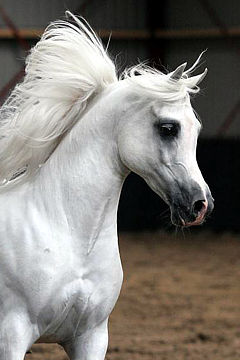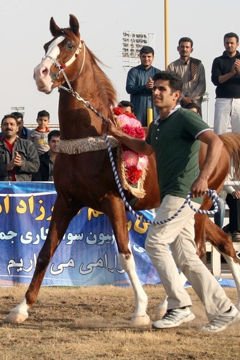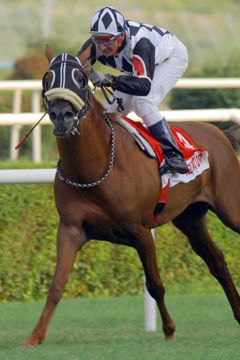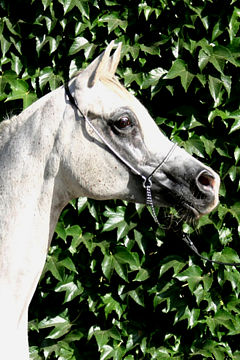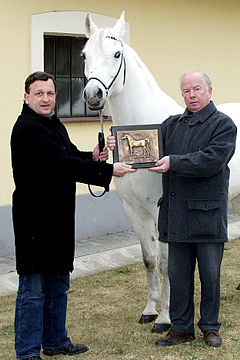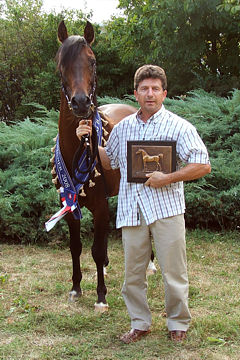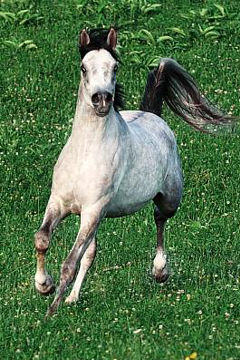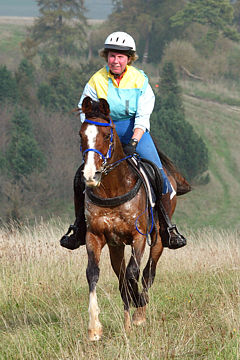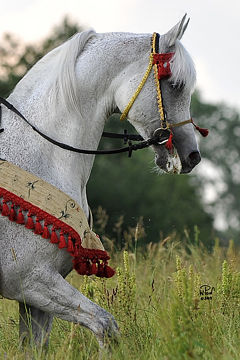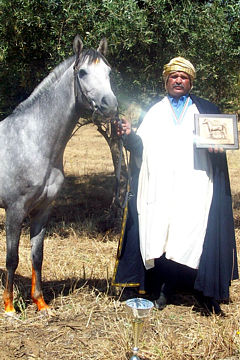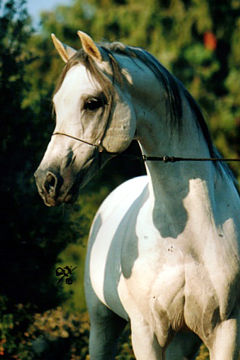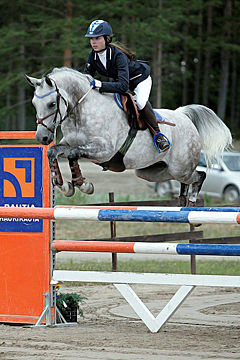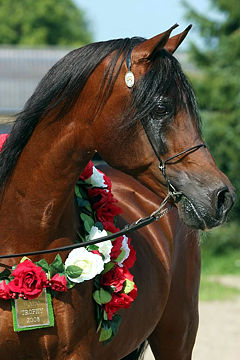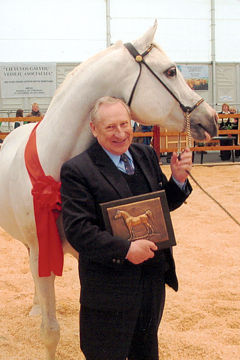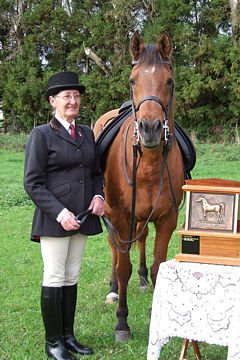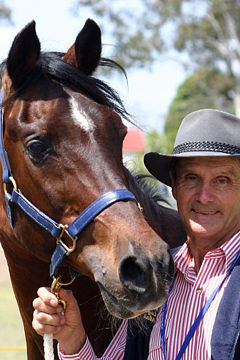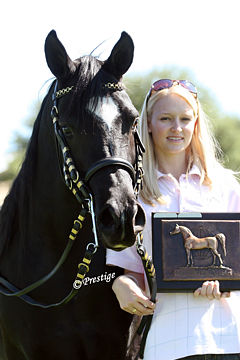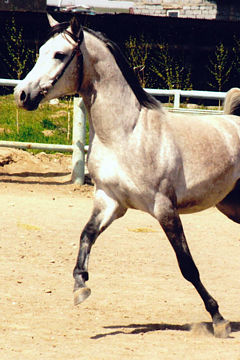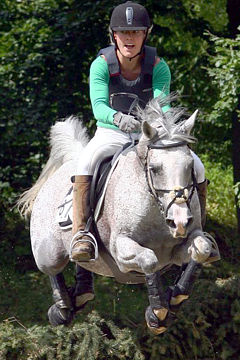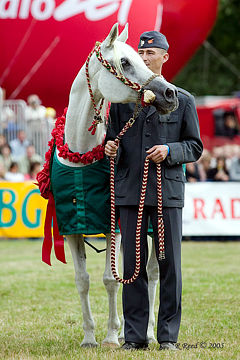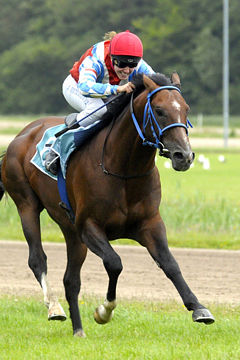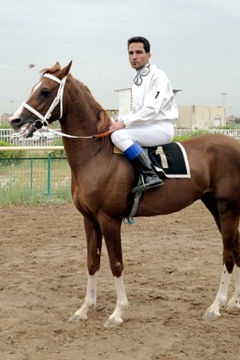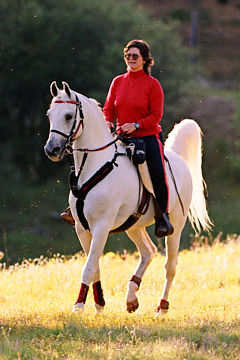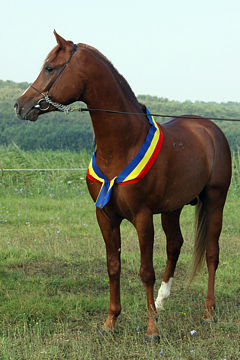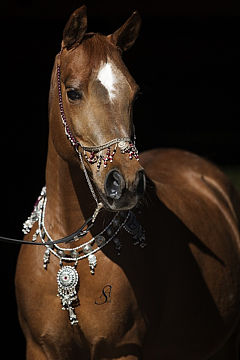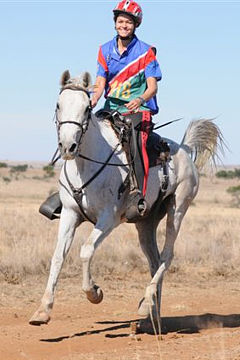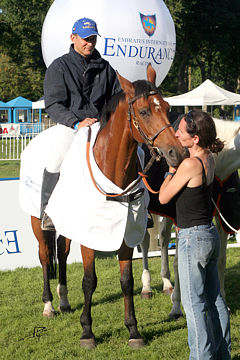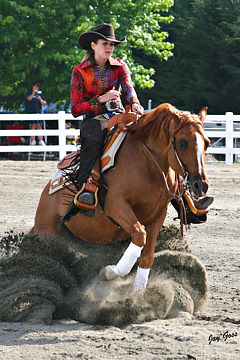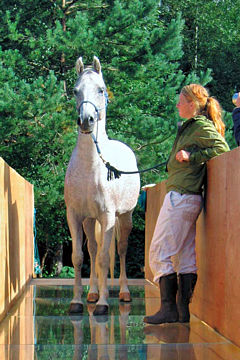WAHO Conference
and Natalie Meredith and Wieslaw Pawlowski. Reproduction in any form prohibited.”

The 2004 WAHO Conference was held at the Marriott Hotel, Warsaw, thanks to the kind invitation and generous hospitality of our hosts, the Polish Agricultural Property Agency and the Jockey Club of Poland, under the patronage of the Ministry of Agriculture. Poland was one of the Founder Members of WAHO, and is one of the most important Arabian horse breeding countries in the west, with a long and distinguished history of breeding fine Arabian horses going back to the 16th century, which has continued down the centuries. Arabians from the world-famous Polish State Studs have been exported to every part of the world, founding important families in many WAHO stud books.
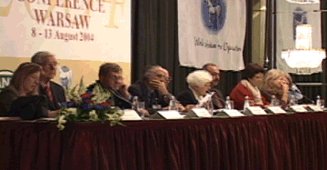
WAHO 2004 Executive Committee
WORLD REGISTRARS MEETING
In addition, the World Registrars Meeting took place on Monday 9th August. This meeting was Co-Chaired by James Carine of Great Britain and Xavier Guibert of France, both previous Registrars of their respective countries. This is a very important meeting for the Registrars, and once again it proved to be a positive and productive forum for discussion. A number of agenda items were discussed, such as mandatory parentage verification of foals; the practical problems arising from the changeover from blood-typing to DNA; micro-chipping as an additional aid to identification; correct interpretation and application of WAHO rules such as those for Horses In Transit, Import & Export, Embryo Transfer, the use of Semen Collection and Insemination Report forms and passports; issuing of stud books; and the creation of the new WAHO pedigree database. The Registrars were unanimous in their decision to reject cloning of Arabian horses.
There was also an election to appoint the members of the new WAHO Stud Book Advisory Sub-Committee, from nominations received. The formation of this Sub-Committee had been discussed and agreed at the 2002 Conference, its remit is to assist the Executive Committee with investigations into any registration or stud book matters whenever called upon to do so. It had previously been agreed that one Registrar from each geographical “area” of WAHO would be represented on this Committee. The final membership is as follows: Chairman (Independent) Mr. James Carine; Members: Mr. Xavier Guibert, Mr. Essam Abdulla; Dr. Mohammed Machmoum, Dr. Jose Luis Canelon; Dr. Bruce McCrea, Miss Helen Dohan and Dr. Nihat Pakdil.
2004 WAHO CONFERENCE
Warsaw is a historic city which has seen many wars and much destruction, and many changes in the past centuries, with perhaps the greatest changes coming in the past decade or so. However, despite the destruction of much of the city in World War II, Poland and its citizens once again showed their eternal optimism and love of their country in rebuilding most of the city’s old landmark buildings to their original appearance. The Old Town, situated on the banks of the Vistula River, is one such shining example, and has been named a World Heritage Site.
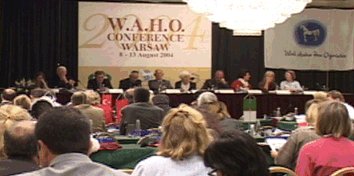
WAHO 2004 Conference in session
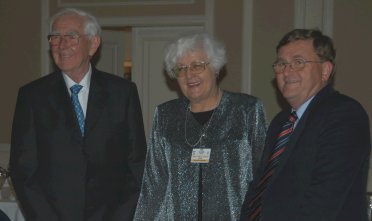
Hans Nagel, Izabella Zawadzka and Peter Pond
TUESDAY AUGUST 10th
The 2004 WAHO Conference was officially opened by the Polish Minister of Agriculture, Mr. Wojciech Olejniczak. There were 45 Registering Authority Member countries represented by Voting Delegates seated to conduct the official business and a further large group of Individual Associate Members attending as Observers, who often participated in the discussions. As always, simultaneous translation was available into English, Polish, Arabic and French.
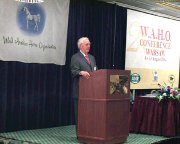
Hans Nagel
The next few Agenda items followed in swift succession. First, the Executive Committee were introduced and reconfirmed by vote of the General Assembly. Two new countries were accepted as full Registering Authority Members of the World Arabian Horse Organization, on distribution of their first Arabian horse stud books, that is to say Slovenia and Azerbaijan. Both were welcomed with applause to the family of WAHO. The normal formalities of adopting the annual accounts and re-appointing the Auditors did not take long. A report was also made to the General Assembly by the Co-Chairmen of the Registrars Meeting, to bring everyone up to date on their discussions and decisions.

Hans Nagel, Peter Pond, Federico Garcia Brum and David Angold
Tuesday evening brought the group to the delightful little “Palace on the Water” in Lazienki Park for cocktails accompanied by an unforgettable recital of Chopin’s piano music, followed by dinner at the nearby Belvedere Restaurant.
WEDNESDAY AUGUST 11th
The Conference reconvened in the morning. The main Agenda item of the day was the discussion and vote on closing the WAHO stud books to any new horses which do not trace to horses previously registered in a WAHO-accepted stud book. This topic has been of major importance to WAHO for many years and was last formally discussed as an agenda item by the General Assembly in Bahrain in 1998, when the vote was to leave the books open. At the Warsaw Conference, the topic again led to much discussion, with contributions from many voting delegates and from several of the observers. Sincere and cogent arguments were made by those with views on both sides of the issue at hand. The final vote passed the motion to close the world’s Arabian stud books, with 26 voting yes, 14 voting no and 4 abstentions. This means that, from 31st October 2004, the only Pure Bred Arabian horses which members may register are those which trace to horses already registered in a WAHO recognized stud book.
After a coffee break, the rest of the morning was taken up with Guest Speakers. Everyone thoroughly enjoyed watching a specially made and very beautiful film, “The Purebred Arabian horses of Poland,” which was introduced by Mrs. Anna Stojanowska, Head Specialist on Horse Breeding at the Agricultural Property Agency. With historic footage as well as modern images, the film elegantly encapsulated the story of the Arabian horse in Poland and was the perfect introduction for first-time visitors to Poland. Our generous hosts presented every participant with a DVD of this film which was truly a marvellous memento to take home, as it is the kind of film one can enjoy watching many times over.
This was followed by a fascinating illustrated lecture by Mr. Krzysztof Zaleski, Curator of the Collection of Polish Drawings at the National Museum of Warsaw. He took as his topic “The Arabian Horse in Polish Art”. He introduced the audience to a wealth of rich images, with colour slides showing paintings and watercolours by famous artists such as Juliusz Kossack and many others equally talented but less well known outside Poland. The highlight for many people was the presence, in the Conference Hall, of four original works, one a relatively modern oil painting by Mr. Novak-Zemplinski of Skowronek, and three original watercolours by Juliusz Kossack of the foundation desert-bred horses Mlecha, Sahara and Koheilan.
The conference then adjourned until the following morning, as participants enjoyed yet another delicious buffet lunch before a very special afternoon event which everyone was greatly anticipating. A full report on the Arabian Horse Parade appears at the end of this article on the Conference.

- Dr Matthew Binns
2004 WAHO CONFERENCE, FINAL DAY
The final full day of the 2004 WAHO Conference started in the morning with what was later agreed to be one of the best ever lectures at a WAHO General Assembly. Our distinguished Guest Speaker was Professor Matthew Binns, Head of Genetics at the Animal Health Trust, UK, and his subject was “Developments in Horse Genetics Related to Inherited Characteristics and Diseases.” Talking with humour and in clear, easy to understand terminology, this was not only extremely informative, bringing us up to date on the latest research and findings from the world of equine science, but also very entertaining. An interesting question and answer session followed, with contributions from many participants.
After coffee, the meeting reconvened with interesting and detailed reports from those Registering Authority Member countries which still retain some form of stallion licensing or grading. This was intended to inform all present on the different practices in different parts of the world. However, the Executive Committee made it clear that they continue to uphold the longstanding WAHO policy against stallion licensing which they consider discriminatory. They clarified the WAHO rule that all foals born of correctly registered Arabian sires and dams must be eligible for registration. Xavier Guibert also gave a very interesting talk to the meeting on the latest EU rules and projects, not only about stallion licensing but also about the Universal Equine Life Number system.
The Delegates also voted unanimously that they did not condone cloning, and that cloned Arabian horses would not be eligible for registration.
During the final afternoon session, the Executive Committee took time to inform the meeting about their plans for the future. Suitable premises for a WAHO Headquarters building are still being sought, although further funding will be needed to make this project a reality. It was announced that a new WAHO Trophy will be given to every Member country, which it is hoped will do a great deal to bring the Arabian horse to the attention of the general public in a positive light. This fine bronze bas-relief sculpture of the WAHO logo has been specially commissioned, and WAHO has requested that it be awarded annually to one Arabian horse of each Member Country’s choice. WAHO has informed Member Countries that they should choose the annual recipient to reward excellence in all spheres of performance, as well as to reflect achievements in open competition against other breeds and maybe also to encourage young riders. This is to be a perpetual challenge trophy, and each winner will also get a special certificate as a permanent reminder of their achievement. Each country was asked to report back to WAHO with photographs and written details on their winners, to include in future WAHO newsletters.
Also during this session WAHO’s Vice- President Peter Pond went through some of WAHO’s main rules, and detailed which are mandatory and which are guidelines. The main cornerstone of WAHO remains our Definition, voted as mandatory by the General Assembly in Bahrain, in 1998. The plans for the next two years were also discussed, basically these are to continue efforts to promote the knowledge of the Arabian horse through education on the history and heritage of the breed. Further details were given about plans to complete the WAHO World Pedigree Database project. The long term aim of this Database is to have every Arabian horse recorded, the data being provided by the Member Registries themselves. Only contributing Registries can alter or amend their own data. When the system is developed in the future to give public access via the internet, this is intended to be a free service for Members. A fee would be charged to members of the public wishing to access the pedigree data, and the country in which the horse in question was first registered will receive a percentage of that fee thus generating some income for both WAHO and the Registering Authority Members who own the data in their stud books.
Then, an announcement was made by Basil Jadaan of Syria, who is also member of the Executive Committee, that the next WAHO Conference will be held in Damascus, Syria, from 10-15 September 2006. His presentation began with a light-hearted moment. The Syrian delegation presented WAHO President Hans-J. Nagel with a traditional black and gold robe and named him “Sheikh of WAHO”. As part of this presentation, our Syrian hosts for 2006 distributed lovely hand-made bags containing colourful literature on the country, its ancient sites and beautiful horses, together with an initial brochure outlining the programme of the next Conference.
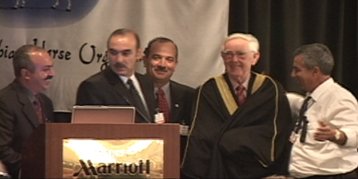
WAHO President Hans-J. Nagel, the “Sheikh of WAHO”
The 2004 WAHO Conference then concluded with each Member of the new Stud Book Advisory Sub-Committee thanking our Polish hosts, and in particular the Polish Agricultural Property Agency, the Jockey Club of Poland and the Ministry of Agriculture, on behalf of their regions.
The final evening of every WAHO Conference traditionally consists of a Gala Dinner Dance and this year was no exception. This was held, very conveniently, in the glittering ballroom of The Marriott Hotel, where the conference had been held. All the participants take the opportunity to dress in their finest formal attire and enjoy the party. We were treated to a colourful floor-show of traditional and elegant Polish dancing, with some extra joviality in the form of a whip-cracking competition. There were farewell speeches from our Polish hosts, and a very moving speech from Dr. Hans-J. Nagel, in which a very special toast was raised to the Immediate Past President and President Emeritus of WAHO, the father of WAHO, Jay Stream.
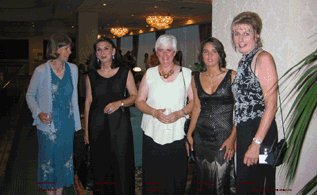
Gala Dinner group
ARABIAN HORSE PARADE, WEDNESDAY 11TH AUGUST
After lunch we left for the Polish Arabian Horse Parade set in the beautiful wooded parkland alongside the historic racecourse at Sluzewiec, which everyone later agreed was the highlight of the whole week. The Directors of the three State Studs of Janow Podlaski, Bialka and Michalow, together with Polands increasing number of private breeders, had worked and planned to prepare an extraordinary and unique presentation of Polish Arabians, brought together from all over the country.
Normally when visiting Poland, one sees the horses either at their home farms or in competition with each other at the shows. What was unique about this Parade is that the horses were presented as a National group, giving the audience an insight into both the tradition and the innovation of the Polish Arabian breeding programme. It also gave a rare opportunity to see groups of related horses from the different stud farms follow each other into the arena, representing the most famous modern families in Poland, for example the Janow Podlaski “A” and “P” mare families, and the Michalow “E” and “W” mare families, to name but a few.
The first horses presented were the stallions, representing different sire lines. They were followed by the female groups and individuals, here representing different foundation mare dam lines. During the two hours, group after group delighted the audience, with up to four generations of famous families from each stud following one another into the specially prepared arena. The weather was kind, the commentary by Anna Stojanowska and Scott Benjamin was informative and detailed, and the horses were, quite simply, breath-taking. Many World, European, National and Nations Cup Champions, as well as leading racehorses, were presented with an elegance and lightness of touch that characterizes the Polish way of showing Arabian horses. From the charismatic masculine stallions, to the ethereal beauty of the mares and the cheeky presence of some self-confident foals, the presentation flew by.
Stallions representing the foundation Sire lines included:
| Representing Bairactar, (1813, Seglawi Jedran), imported 1817 to Weil: | |
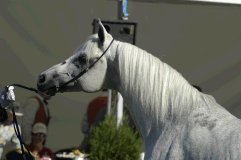 Balon (grey, 1979, Gwarny-Ballada). Janow Podlaski; |
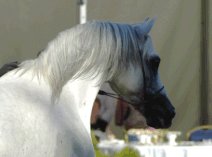 Kulig (grey, 1991, Balon-Kawalkada). Michalow. |
| Representing Ibrahim, (1899), imported 1907 to Antoniny: | |
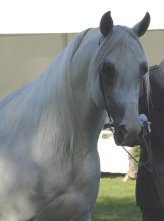 Harbin (grey, 1993, Eukaliptus-Halfa). Janow Podlaski |
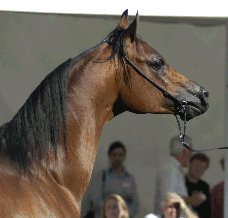 Aslan (grey, 1998, Eukaliptus-Algora). Janow Podlaski. |
Grafik (grey, 1996, Eukaliptus-Gaskonia). Michalow.
Salar (grey, 2000, Ecaho-Saba). Janow Podlaski.
| Representing Ilderim, (1894), imported 1900 to Antoniny. | |
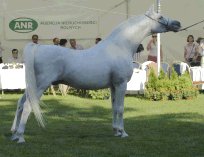 Eldon (grey, 1985, Penitent-Erotyka). Michalow. |
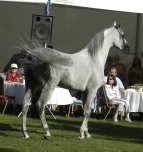 Espadero (grey, 1997, Eldon-Esparceta). Janow Podlaski. |
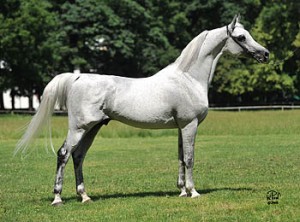 Piaff (grey, 1997, Eldon-Pipi). Janow Podlaski.
Piaff (grey, 1997, Eldon-Pipi). Janow Podlaski.
Representing Krzyzyk, (1869, Koheilan), imported 1876 to Jarczowce:
Wachlarz (bay, 1990, Arbil-Warsowia). Michalow.
| Representing Saklawi I, (1886, Saklawi Jedran, brought to Ali Pasha Sherif, Egypt, by the Rualla tribe): | ||
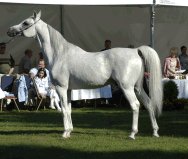 Ararat (grey, 1985, Palas-Arra). Janow Podlaski. |
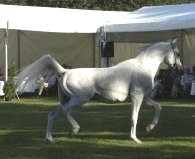 Emigrant (grey, 1991, Ararat-Emigrantka). Michalow. |
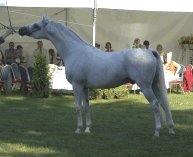 Emrod (grey, 1997, Emigrant-Empressa). Michalow. |
Representing Kuhailan Afas, (1930, bred by HH Emir Eissa AlKhalifa in Bahrain), imported 1931 to Gumniska:
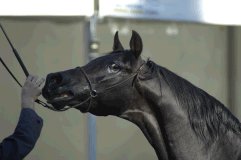
Fawor
(1981, brown, Probat-Fatma).
Michalow.
Representing Kuhailan Haifi, (1923) imported 1931 to Gumniska:
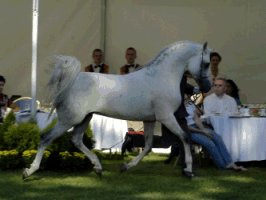
Ekstern
(grey, 1994, Monogramm-Ernestyna).
Michalow.
Ganges (bay, 19994, Monogramm – Garonna). Michalow.
Mares representing the foundation Arab Dam lines included:
| Representing the dam line of Gazella, (Kehailet Ajuz), imported 1845 to Jarczowce: | |
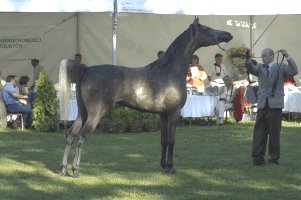 Groteska (grey, 2000, Emigrant-Gracja-Bis). Niewierz Stud. |
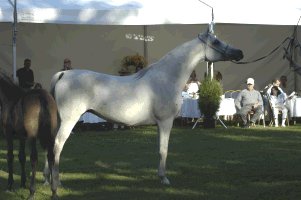 Georgia (grey, 1994, Monogramm-Gizela) Michalow. |
Gracja-Bis (chestnut, 1995, Monogramm-Grenada). Niewierz Stud.
Gracjana (bay, 2003, Fawor-Gracja-Bis). Sowiniec Stud.
Ciarka (grey, 2002, Pesal-Cirka). Bialka Stud.
Gehenna (grey, 1995, Monogramm-Gizela) & her colt foal by Gazal Al Shaqab. Michalow.
Representing the dam line of Mlecha, (Kehaileh Dajanieh), imported 1845 to Jarczowce:
Heroldia (grey, 1992, Eukaliptus-Heraldyka). Kurozweki Stud.
Herca (grey, 2000, Pesal – Heroldia). Bialka Stud.
Representing the dam line of Sahara, (Kehaileh Moradi), imported 1845 to Jarczowce:
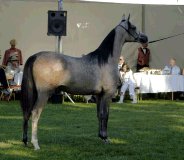
Euspira
(grey, 2003, Gazal Al Shaqab-Euskara).
Bialka Stud
| Representing the dam line of Milordka, approx. 1810, to Slawuta: | |
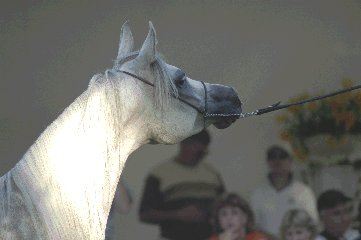 Emira (grey, 2000, Laheeb-Embra). Michalow. |
|
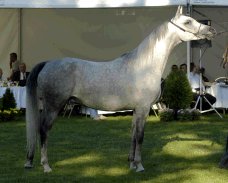 Emika (grey, 199, Eldon-Emoza). Bialka Stud. |
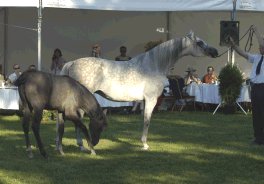 Emmona (grey, 1998, Monogramm – Emilda) And her filly foal by Gazal Al Shaqab Michalow. |
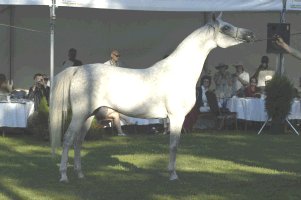 El Dorada (grey, 1998, Sanadik El Shaklan – Emigrankta). Michalow. |
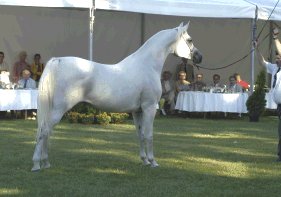 Emanda (grey, 1996, Ecaho-Emanacja) Michalow. |
Representing the dam line of Ukrainka, approx. 1815, to Slawuta:
Fraskata (grey, 1993, Pers-Frasquita). Bialka.
Representing the dam line of Szweykowska, approx. 1800 to Slawuta:
Wieza Babel (grey, 2000, Laheeb-Wiazma). Michalow.
Wilga (grey, 1999, Ekstern-Wenessa) & her filly foal by Gazal Al Shaqab. Michalow.
| Representing the dam line of Szamrajowka, approx. 1810 to Bialocerkiew: | |
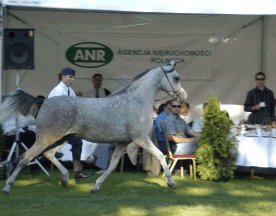 Palmeta (grey, 2001, Ecaho-Pilica). Janow Podlaski. |
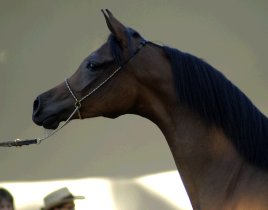 Pianissima (bay, 2003, Gazal Al Shaqab-Pianosa) Janow Podlaski |
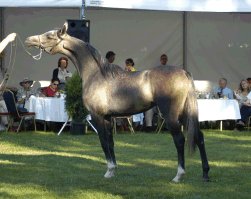 Perfirka (grey, 2003, Gazal Al Shaqab-Perforacja) Bialka Stud. |
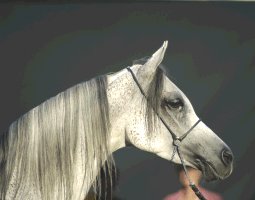 Pilar (grey, 1996, Fawor-Pipi) Janow Podlaski. |
Pieta (grey, 2003, Gazal Al Shaqab-Pilar). Janow Podlaski
Pianosa (bay, 1998, Eukaliptus-Pinia). Janow Podlaski
Representing the dam line of Rodania, (1869, Kehailet Ajuz of Ibn Rodan), imported 1881 to England:
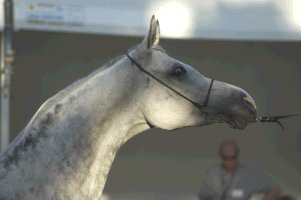
Palmira
(grey, 1995, Monogramm-Palestra).
Michalow.
Representing the dam line of Bent-El-Arab, (1880, Kehailet Ajuz), imported 1885 to Babolna:
Celina (chestnut, 2003, Metropolis NA-Cyfra). Bialka.
Representing the dam line of Scherifa, (1896, Kehailet El Sherif), imported 1902 to Babolna:
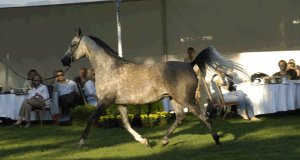
Altona
(grey, 1999, Eukaliptus-Albigowa).
Janow Podlaski.
Amra (grey, 2000, Eukaliptus-Albigowa). Janow Podlaski
Alhambra (grey, 2002, Ecaho-Albigowa). Janow Podlaski
Finally, three young horses were shown to the audience, specially selected to represent Arabians currently in training at the racetrack, which have already been succesful junior Show horses, to illustrate Poland’s long-standing tradition of racing their horses prior to selection for their breeding programme, to ensure their soundess in wind, limb and temperament:
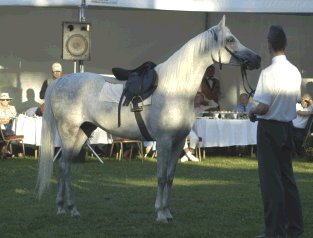 Siklawa (2001 grey filly Laheeb x Siewka). Janow Podlaski |
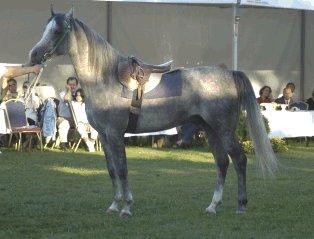 Poganin (2001 grey colt Laheeb x Pohulanka)). Janow Podlaski. |
Galia-Bis 2001 grey filly (Pamir x Gracja-Bis) from Niewierz Stud
At the end of the presentation, the three Directors of the State Studs, Dr. Marek Trela, Mr. Jerzy Bialobok and Dr. Jerzy Urbanski were introduced to the audience, who rewarded them with a well deserved round of applause.
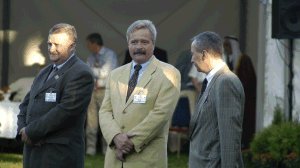
INTERNATIONAL ARABIAN RACE DAY, FRIDAY AUGUST 13th
The day after the Conference ended, all participants were cordially invited to go racing. Friday morning found everyone leaving their hotels, some very early to participate in another sightseeing tour of Warsaw and the Royal Palace at Wilanow. Others elected to leave a little later and go direct to the Warsaw-Sluzewiec Racetrack for the International Arabian Race Day, hosted by Mr. Jerzy Budny, President of the Polish Jockey Club.
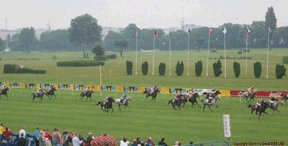
Despite the somewhat inclement weather, with intermittent heavy rain, everyone thoroughly enjoyed watching a full card of Arabian races, including three important international races – the Bialka Stakes (for 3 year olds, distance 2000 m), the Sabellina Stakes (for fillies aged 4 and over, 2000 m) and the Europa Cup (for 4 year olds and over, 2600 m).
The Bialka Stakes was won by a very attractive and athletic German-bred filly of Polish pedigree, Wienerva (Santhos – Wierna Rzeka) with three sons of the Polish Derby winner Pamir all bred by Bialka Stud taking 2nd, 3rd and 4th places. They were Perkal (out of Perforacja), Alpar (out of Albia) and Wodospad (out of Wola).
The Sabellina Stakes produced yet another winner from the same famous Janow “S” family which produced Sabellina herself. The latest addition to this illustrious family of winners was Salsa, by Wojslaw out of triple-crown winner Sarmacja. Actually the first past the post was Eqvida (Wojslaw-Eqviria), also from Janow, but placings were reversed after an objection by the 2nd to the winner, thus giving Janow Podlaski Stud both 1st and 2nd places in this illustrious race.
The Europa Cup was truly international, bringing together 16 of the best Arabians of their generation in Europe, with runners from Sweden, Germany, Britain, Austria, Holland and Russia, as well as from Poland. The field included many major race winners such as the Russian colts Vikont (Kartel/Vilma) and Seliger (Balaton/Greshnica) and several Swedish runners including the full brothers El Wodkine and El Waldo (Eldorado/Welona) and the 2003 Europa Cup winner, Millennium (Almir/Tatarka) with his half brother Hespeshal (Izentespeshal/Tatarka). In the event, the race was won in emphatic style by the 5 year old Polish-bred Gorec, avenging his 2003 defeat by Millennium in this same race. The full brothers from Sweden, El Wodkine and El Waldo, finished in 2nd and 3rd. Gorec, himself a Polish Derby winner, is by Polish Derby winner Druid out of the race-winning Russian mare Gordaia. Bred and trained by Anna Nieora-Tchkauseli, Gorecis win was a triumph for the increasing number of private breeders in Poland.
After the races, the participants of the 2004 WAHO Conference gathered themselves and their luggage into a variety of buses which went off in several directions, some returning to Warsaw Hotels as people prepared to fly home, others setting off into the Polish countryside on their way to Janow Podlaski for the Arabian Horse Days festival, the first of the Post Conference Tours. Fortunately eventually everyone reached their intended destination with the right luggage, despite a few delays along the way.
The excellent selection of optional Post Conference Tours that had been arranged by our hosts not only included the Arabian Horse Days at Janow Podlaski comprising the 2004 Polish National Championships Show and annual Pride of Poland Auction, but also included optional visits to Bialka and Michalow State Studs. Tours were also offered to the historic and beautiful cities of Krakow and Gdansk, and many people took the opportunity to extend their visit to Poland to enjoy these specially arranged trips. Complete details of the results of the Show and the Auction will not be included here, as they have been written up fully in many magazines and are also available at the websites of the State Studs, for example: www.janow.arabians.pl/en or www.michalow.arabians.pl/en
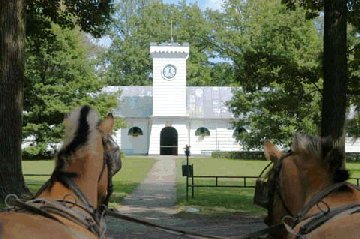
Clock Tower Stables
WITH THANKS
WAHO would like to take this opportunity to thank the following people for their generosity and kindness in hosting or arranging the 2004 WAHO Conference in Poland. Together they ensured that this Conference was one of the most memorable and special WAHO Conferences ever held.
- Mr. Wojciech Olejniczak, The Minister of Agriculture
- Mr. Jerzy Pilarczyk, Secretary of State, Ministry of Agriculture
- Mrs. Jolanta Szymanek-Deresz, Head of Chancellery of the President of Poland
- Mr. Zdzislaw Siewierski, President of The Agricultural Property Agency
- Mr. Jerzy Budny, President of The Polish Jockey Club
- Mr. Karol Gïbka, Vice President, Agricultural Property Agency
- Mr. Miroslaw Helta, Director, Agricultural Property Agency
- Mr. Jïzef Urbaiski, Deputy Director, Agricultural Property Agency
- Mr. Tadeusz Kredkiewicz, Administrator of Sluzewiec Racecourse
- Mrs.Izabella Pawelec-Zawadzka, President, Polish Arabian Horse Breeders Society
- Mr. Jerzy Bialobok, Director, Stadnina Koni Michaliw
- Dr. Marek Trela, Director, Stadnina Koni Janiw Podlaski
- Mr. Jerzy Urbanski, Director, Bialka State Stud
- Mrs. Anna Stojanowska, Agricultural Property Agency
- Mr. Witold Sniec, Agricultural Property Agency
- Mrs. Grazyna Kapelko, Agricultural Property Agency
- Mrs. Ewa Hawrylewicz, Agricultural Property Agency
- Mr. Jan Zerko, Agricultural Property Agency
- Mrs. Hanna Myjak, Agricultural Property Agency
- Miss Urszula Leczyka, Agricultural Property Agency
- The directors and staff of Furnel Travel International
- The management and staff of the Warsaw Marriott Hotel

